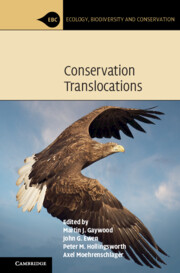Book contents
- Frontmatter
- Dedication
- Contents
- Contributors
- Foreword
- Preface
- Acknowledgements
- Part I Conservation Translocations: Getting Started
- Part II Conservation Translocations: The Key Issues
- Part III Conservation Translocations: Looking to the Future
- Part IV Case Studies
- 14 Reintroduction of the Endemic Plant Manglietiastrum sinicum (Magnoliaceae) to Yunnan Province, China
- 15 Applying Adaptive Management to Reintroductions of Pyne’s Ground-Plum Astragalus bibullatus
- 16 Five Reasons to Consider Long-Term Monitoring: Case Studies from Bird Reintroductions on Tiritiri Matangi Island
- 17 Multiple Reintroductions to Restore Ecological Interactions in a Defaunated Tropical Forest
- 18 Bringing Jaguars and Their Prey Base Back to the Iberá Wetlands, Argentina
- 19 The Return of the Eurasian Beaver to Britain: The Implications of Unplanned Releases and the Human Dimension
- 20 The Role of Community Engagement in Conservation Translocations: The South of Scotland Golden Eagle Project (SSGEP)
- 21 The European Native Oyster and the Challenges for Conservation Translocations: The Scottish Experience
- 22 Slow and Steady Wins the Race: Using Non-native Tortoises to Rewild Islands off Mauritius
- 23 Assisted Colonisation as a Conservation Tool: Tasmanian Devils and Maria Island
- Index
- Plates
23 - Assisted Colonisation as a Conservation Tool: Tasmanian Devils and Maria Island
from Part IV - Case Studies
Published online by Cambridge University Press: 07 December 2022
- Frontmatter
- Dedication
- Contents
- Contributors
- Foreword
- Preface
- Acknowledgements
- Part I Conservation Translocations: Getting Started
- Part II Conservation Translocations: The Key Issues
- Part III Conservation Translocations: Looking to the Future
- Part IV Case Studies
- 14 Reintroduction of the Endemic Plant Manglietiastrum sinicum (Magnoliaceae) to Yunnan Province, China
- 15 Applying Adaptive Management to Reintroductions of Pyne’s Ground-Plum Astragalus bibullatus
- 16 Five Reasons to Consider Long-Term Monitoring: Case Studies from Bird Reintroductions on Tiritiri Matangi Island
- 17 Multiple Reintroductions to Restore Ecological Interactions in a Defaunated Tropical Forest
- 18 Bringing Jaguars and Their Prey Base Back to the Iberá Wetlands, Argentina
- 19 The Return of the Eurasian Beaver to Britain: The Implications of Unplanned Releases and the Human Dimension
- 20 The Role of Community Engagement in Conservation Translocations: The South of Scotland Golden Eagle Project (SSGEP)
- 21 The European Native Oyster and the Challenges for Conservation Translocations: The Scottish Experience
- 22 Slow and Steady Wins the Race: Using Non-native Tortoises to Rewild Islands off Mauritius
- 23 Assisted Colonisation as a Conservation Tool: Tasmanian Devils and Maria Island
- Index
- Plates
Summary
Tasmanian devils are endangered due to an infectious clonal cancer that has reduced populations by up to 80 per cent since it first arose in 1996. As part of a management strategy for the species, an island population was established through an assisted colonisation event on Maria Island National Park. The original scope of the Maria Island population was to establish and maintain a disease-free population of devils. The island is now used as a source site for these trial releases of devils to mainland Tasmania populations. The 2012 release cohort to the island had a high degree of relatedness. However, through dedicated management strategies, including contraception and selective harvesting, this situation has been rectified and the Maria Island population now represents a genetically diverse group. Monitoring, using traditional methods of trapping and camera traps, in addition to genetic monitoring, has been essential to the establishment and maintenance of the Maria Island population.
Keywords
- Type
- Chapter
- Information
- Conservation Translocations , pp. 476 - 483Publisher: Cambridge University PressPrint publication year: 2022

